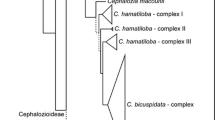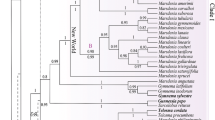Abstract
The phylogenetic relationships of the monotypic Chinese genus Anemoclema (Ranunculaceae) within tribe Anemoneae are unclear and its taxonomic status has long been in dispute. Here we present a molecular analysis to address the problems. Nuclear ITS and plastid atpB-rbcL fragments were analyzed using maximum parsimony, maximum likelihood, and Bayesian inference methods. Within tribe Anemoneae, two strongly supported clades corresponding to subtribes Anemoninae and Clematidinae are recovered. Anemoclema and Clematis s.l. are sister within the Clematidinae and Anemone s.l., a genus previously regarded as closely related to or congeneric with Anemoclema, is alone within Anemoninae clade. Our results demonstrate that Anemoclema is more closely related to Clematis than to Anemone, and thus should be transferred from Anemoninae into Clematidinae. From a morphological perspective and with the intention of maintaining nomenclatural stability we suggest that Anemoclema be recognized as a second genus within Clematidinae.



Similar content being viewed by others
References
Bergsten J (2005) A review of long-branch attraction. Cladistics 21:163–193
Boufford DE, van Dijk PP (2004) Mountains of southwest China. In: Mittermeter RA, Gil PR, Hoffman M et al (eds) Hotspot revisited: earth’s biologically richest and most endangered ecoregions. Cemex, Mexico, pp 159–164
Doyle JJ, Doyle JL (1987) A rapid DNA isolation procedure for small quantities of fresh leaf tissue. Phytochem Bull 19:11–15
Edgar RC (2004) Muscle: multiple sequence alignment with high accuracy and high throughput. Nucl Acids Res 32:1792–1797
Ehrendorfer F (1995) Evolutionary trends and patterns in the Anemoninae. Pl Syst Evol [Suppl.] 9:283–293
Ehrendorfer F, Samuel R (2001) Contributions to a molecular phylogeny and systematics of Anemone and related genera (Ranunculaceae-Anemoninae). Acta Phytotax Sin 39:293–307
Farris JS, Källersjö M, Kluge AG, Bult C (1995) Testing significance of incongruence. Cladistics 10:315–319
Fei Y (2000) Anemoclema (Franch.) W.T.Wang. In: Wu ZY (ed) Flora Yunnanica, vol 11. Science Press, Beijing, pp 204–206
Felsenstein J (1985) Confidence limits on phylogenies: an approach using the bootstrap. Evolution 39:783–791
Franchet A (1886) Plantae yunnanensis, a cl. J. M. Delavay collectas, enumerat novasque descritit (1). Bull Soc Bot France 33:358–467
Franchet A (1889) Plantae delavayae, vol 1. Paul Klineksieck, Paris, pp 6–7
Fu DZ, Robinson OR (2001) Anemoclema (Franch.) W.T.Wang. In: Wu ZY, Peter PH (eds) Flora of China, vol 6. Science Press/Missouri Botanical Garden Press, Beijing/St Louis, pp 328–329
Hall TA (1999) BioEdit: a user-friendly biological sequence alignment editor and analysis program for Windows 95/98/NT. Nucl Acids Symp Ser 41:95–98
Handel-Mazzetti H (1931) Symbolae Sinicae, VII. Teil. Verlag von Julius Springer, Wien, p 314
Hoot SB, Reznicek AA, Palmer JD (1994) Phylogenetic relationship in Anemone (Ranunculaceae) based on morphology and chloroplast DNA. Syst Bot 19:169–200
Hoot SB, Meyer KM, Manning JC (2012) Phylogeny and reclassification of Anemone (Ranunculaceae), with an emphasis on austral species. Syst Bot 37:139–152
Huth E (1897) Über Schwierigkeiten und Ungenauigkeiten in der Nomenclatur der Gattung Pulsatilla. Bot Jahrb Syst 22:582–592
Jiang N, Guan KY (2012) Lectotypification of Anemoclema glaucifolium (Ranunculaceae), endemic to southwestern China. Phytotaxa 57:56–58
Li LQ (1993) Anemoclema (Franch.) W.T.Wang. In: Wang WT (ed) Vascular plants of the Hengduan Mountains, vol 1. Science Press, Beijing, pp 516–517
Meyer KM, Hoot SB, Arroyo MTK (2010) Phylogenetic affinities of South American Anemone (Ranunculaceae), including the endemic segregate genera, Barneoudia and Oreithales. Int J Pl Sci 17:323–331
Miikeda O, Kita K, Handa T, Yukawa T (2006) Phylogenetic relationships of Clematis (Ranunculaceae) based on chloroplast and nuclear DNA sequences. Bot J Linn Soc 152:153–168
Nowicke J, Skvarla JJ (1995) Ranunculaceae 8. Pollen morphology. In: Hiepko P (ed) Die Natürlichen Pflanzenfamilien, Zwei. Aufl. vol 17a(4). Duncker and Humblot, Berlin, pp 129–159
Pfosser M, Sun BY, Stuessy TF, Jang CG, Guo YP, Taejin K, Hwan KC, Kato H, Sugawara T (2011) Phylogeny of Hepatica (Ranunculaceae) and origin of Hepatica maxima Nakai endemic to Ullung Island, Korea. Stapfia 95:16–27
Posada D, Crandall KA (1998) Modeltest: testing the model of DNA substitution. Bioinformatics 14:817–818
Ronquist F, Teslenko M, Van der Mark P, Ayres DL, Darling A, Höhna S, Larget B, Liu L, Suchard MA, Huelsenbeck JP (2012) MrBayes 3.2: efficient Bayesian phylogenetic inference and model choice across a large model space. Syst Biol 61:539–542
Schuettpelz E, Hoot SB, Samuel R, Ehrendorfer F (2002) Multiple origins of Southern Hemisphere Anemone species (Ranunculaceae) based on plastid and nuclear sequence data. Pl Syst Evol 231:143–151
Shimodaira H (2002) An approximately unbiased test of phylogenetic tree selection. Syst Biol 51:492–508
Shimodaira H, Hasegawa M (2001) CONSEL: for assessing the confidence of phylogenetic tree selection. Bioinformatics 17:1246–1247
Simmons MP, Ochoterena H (2000) Gaps as characters in sequence-based phylogenetic analyses. Syst Biol 49:369–381
Stapf O (1926) Anemone glauciifolia Franch. Curtis’s Bot Mag 151:9114
Swofford DL (2003) PAUP*. Phylogenetic analysis using parsimony (*and other methods), Version 4.0b10. Sinauer Associates, Sunderland
Tamura M (1967) Morphology, ecology and phylogeny of Ranunculaceae. Sci Rep Osaka Univ 16:21–43
Tamura M (1991) A new classification of the family Ranunculaceae 2. Acta Phytotax Geobot 42:177–187
Tamura M (1995) Trib. Anemoneae DC. In: Hiepko P (ed) Die Natürlichen Pflanzenfamilien, vol 17a. Duncker and Humblot, Berlin, pp 320–388
Ulbrich E (1905–06) Über die systematische Gliederung und geographische Verbreitung der Gattung Anemone L. Bot Jahrb Syst 37:171–334
Wang WT (1964) Duo genera nova Ranunculacearum sinensium. Acta Phytotax Sin 9:103–107
Wang WT (1979) Tribe Anemoneae DC. In: Anonymous (ed) Flora Reipublicae Popularis Sinicae, vol 28. Science Press, Beijing, pp 1–241
Wang W, Lu AM, Ren Y, Endress ME, Chen ZD (2009) Phylogeny and classification of Ranunculales: evidence from four molecular loci and morphological data. Perspect Pl Ecol Evol Syst 11:81–110
Wang W, Hu H, Xiang XG, Yu SX, Chen ZD (2010) Phylogenetic placements of Calathodes and Megaleranthis (Ranunculaceae): evidence from molecular and morphological data. Taxon 59:1712–1720
White TJ, Bruns T, Lee S, Taylor J (1990) Amplification and direct sequencing of fungal ribosomal RNA genes for phylogenetics. In: Innis MA, Gelfand DH, Sinisky JJ, White TJ (eds) PCR protocols: a guide to methods and applications. Academic, San Diego, pp 315–322
Wu CY (1988) Hengduan mountains flora and its significance. J Jap Bot 63:297–311
Xi YZ, Chang KT (1964) Studies on pollen morphology of Anemone L. Acta Bot Sin 12:19–38
Xie L, Li LQ (2012) Variation of pollen morphology, and its implications in the phylogeny of Clematis (Ranunculaceae). Pl Syst Evol 298:1437–1453
Xie L, Wen J, Li LQ (2011) Phylogenetic analyses of Clematis (Ranunculaceae) based on sequences of nuclear ribosomal ITS and three plastid regions. Syst Bot 15:907–921
Yang QE (2002) Cytology of ten species in Anemone, one in Anemoclema and six in Clematis (Trib. Anemoneae, Ranunculaceae) from China. Acta Phytotax Sin 40:396–405
Ying TS, Zhang YL (1994) The endemic genera of seed plants of China. Science Press, Beijing, pp 487–490
Young ND, Healy J (2003) GapCoder automates the use of indel characters in phylogenetic analysis. BMC Bioinform 4:6
Zhang GL, Gong X (2002) The karyotype analysis of Anemoclema glaucifolium and Heteroplexis microcephala both endemic to China. Acta Bot Yunnan 24:765–768
Zhang Y, Hong Y, Ren C, Tang M, Hoot SB, Yang QE (2014) Palynology, cytology, and molecular systematics of Anemone section Begoniifolia (Ranunculaceae). Pl Syst Evol. doi:10.1007/s00606-014-1082-0
Ziman SN, Bulakh EV, Kadota Y, Keener CS (2008) Modern view on the taxonomy of the genus Anemone L. sensu stricto (Ranunculaceae). J Jap Bot 83:127–155
Zwickl DJ (2006) Genetic algorithm approaches for the phylogenetic analysis of large biological sequence datasets under the maximum likelihood criterion. PhD Thesis, University of Texas at Austin, Austin
Acknowledgments
We are grateful to two anonymous reviewers for their invaluable comments on the manuscript. We thank Dr. Chen Ren for much of his help in analyzing molecular data. We also thank Mr. Ce-Hong Li of the Emei Biological Resource Experimental Station, Sichuan Institute of Natural Resources for his help in collecting materials. This work was supported by the Main Direction Program of Knowledge Innovation of the Chinese Academy of Sciences (KSCX2-EW-Z-1).
Author information
Authors and Affiliations
Corresponding author
Additional information
Handling editor: Livia Wanntorp.
Appendix: List of taxa included in this study and GenBank accession numbers and authors
Appendix: List of taxa included in this study and GenBank accession numbers and authors
Anemoclema glaucifolium (Franch.) W.T.Wang, KJ819801, KJ819821, Zhongdian, Yunnan, China, Q. E. Yang 3104 IBSC; KJ819802, KJ819822, Lijiang, Yunnan, China, Q. E. Yang 2649 IBSC. Anemone americana (DC.) H.Hara (= Hepatica americana (DC.) Ker Gawl.), AY055386, AY055407, Hoot et al. 2012. A. balliana (Britton) Hoot (= Barneoudia balliana Britton), FJ639900, FJ639864, Hoot et al. 2012. A. bracteata (Harv. ex Zahlbr.) J.C. Manning & Goldblatt (= Knowltonia bracteata Harv. ex Zahlbr.), JF810692, JF810702, Hoot et al. 2012. A. caffra Harv., AY055399, AY055420, Hoot et al. 2012. A. caroliniana Walt., AY055403, AY055423, Hoot et al. 2012. A. crassifolia Hook.f., AY055398, AY055419, Hoot et al. 2012. A. davidii Franch., KJ819811, KJ819831, Emei Shan, Sichuan, China, Y. Zhang 93 IBSC. A. flaccida Fr.Schmidt, AY055391, AY055412, Hoot et al. 2012. A. halleri All. (= Pulsatilla halleri (All.) Willd.), FJ639908, FJ639872, Hoot et al. 2012. A. hepatica L. (= Hepatica nobilis Mill.), FJ639904, FJ639868, Hoot et al. 2012. A. hupehensis Lem., AY055397, AY055418, Hoot et al. 2012. A. integrifolia Humb. & Bonpl. ex DC. (= Oreithales integrifolia (DC.) Schltdl.), FJ639906, FJ639870, Hoot et al. 2012. A. knowltonia Burtt Davy (= Knowltonia capensis Huth), JF810693, JF810703, Hoot et al. 2012. A. narcissiflora L., AY055393, AY055414, Hoot et al. 2012. A. obtusiloba D.Don, FJ639886, FJ639850, Hoot et al. 2012. A. occidentalis S.Watson (= Pulsatilla occidentalis (S.Watson) Freyn), AY055400, AY055426, Hoot et al. 2012. A. parviflora Michx., FJ639887, FJ639851, Hoot et al. 2012. A. pavonina Lam., FJ639888, FJ639852, Hoot et al. 2012. A. quinquefolia L., JF810686, JF810696, Hoot et al. 2012. A. richardsonii Hook.f., AY055388, AY055409, Hoot et al. 2012. A. rigida Gay, FJ639890, FJ639854, Meyer et al. 2010. A. rivularis Buch.-Ham. ex DC., AY055396, AY055417, Hoot et al. 2012. A. rupicola Camb., FJ639892, FJ639856, Hoot et al. 2012. A. tenuicaulis Parkin & Sledge, AY055389, AY055410, Hoot et al. 2012. A. virginiana L., FJ639898, FJ639862, Hoot et al. 2012. Clematis afoliata Buchanan, AB120193, AB115443, Miikeda et al. 2006. C. alternata Kitam. & Tamura (= Archiclematis alternata (Kitam. & Tamura) Tamura), AB120190, AB115440, Miikeda et al. 2006. C. akebioides (Maxim.) Veitch, GU732574, GU732493, Xie et al. 2011. C. angustifolia Jacq., AB120199, AB115449, Miikeda et al. 2006. C. brevicaudata DC., GU732583, GU732502, Xie et al. 2011. C. chinensis Osbeck, GU732584, GU732503, Xie et al. 2011. C. crassifolia Benth., AB120194, AB115444, Miikeda et al. 2006. C. delavayi Franch., AB120202, AB115452, Miikeda et al. 2006. C. eichleri Tamura, AB120209, AB115459, Miikeda et al. 2006. C. fasciculiflora Franch., AB120203, AB115453, Miikeda et al. 2006. C. florida Thunb., AB120186, AB115436, Miikeda et al. 2006. C. fusca Turcz., AB120179, AB115429, Miikeda et al. 2006. C. hexapetala Pall., GU732597, GU732516, Xie et al. 2011. C. integrifolia L., GU732599, GU732518, Xie et al. 2011. C. japonica Thunb., AB120187, AB115437, Miikeda et al. 2006. C. lasiandra Maxim., AB120185, AB115435, Miikeda et al. 2006. C. lasiantha Nutt. ex Torr. & A.Gray., AB120200, AB115450, Miikeda et al. 2006. C. nobilis Nakai, AB120206, AB115456, Miikeda et al. 2006. C. orientalis L., AB120196, AB115446, Miikeda et al. 2006. C. pierotii Miq., AB120191, AB115441, Miikeda et al. 2006. C. pinnata Maxim., GU732616,GU732535, Xie et al. 2011. C. potaninii Maxim., AB120198, AB115448, Miikeda et al. 2006. C. ranunculoides Franch., GU732621, GU732540, Xie et al. 2011. C. stans Sieb. & Zucc., AB120188, AB115438, Miikeda et al. 2006. C. tangutica (Maxim.) Korsh., GU732633, GU732552, Xie et al. 2011. C. tashiroi Maxim., AB120192, AB115442, Miikeda et al. 2006. C. villosa DC. (= Clematopsis scabiosifolia (DC.) Hutch.), AB120211, AB115461, Miikeda et al. 2006. C. vitalba L., AB120207, AB115457, Miikeda et al. 2006. Naravelia laurifolia Wall. ex Hook.f. & Thomson, AB120208, AB115458, Miikeda et al. 2006. Ranunculus cymbalaria Pursh, AY680196, FJ639873, Meyer et al. 2010. R. ficaria L., AM267275, FJ639874, Pfosser et al. 2011, Meyer et al. 2010. Trautvetteria caroliniensis (Walter) Vail, FJ639909, FJ639875, Meyer et al. 2010.
Rights and permissions
About this article
Cite this article
Zhang, Y., Kong, HH. & Yang, QE. Phylogenetic relationships and taxonomic status of the monotypic Chinese genus Anemoclema (Ranunculaceae). Plant Syst Evol 301, 1335–1344 (2015). https://doi.org/10.1007/s00606-014-1160-3
Received:
Accepted:
Published:
Issue Date:
DOI: https://doi.org/10.1007/s00606-014-1160-3




